Did you know that 60-90% of those who suffer from fibromyalgia, a condition marked by chronic pain and fatigue, are women (and those assigned female at birth)? this disparity has led researchers to investigate potential links with hormonal factors. Intriguingly, recent studies have found that having a close family member with fibromyalgia significantly increases one's own risk of developing the condition by as much as 8 times. So, does this mean that fibromyalgia is hereditary? This article delves into the genetics of fibromyalgia while addressing some common questions about this condition.
Did You Know?
Many chronic conditions like diabetes, hypertension, or fibromyalgia are influenced by many gene changes. Each change adds to the risk of developing the condition. You can learn your risk for these conditions as well as recommendations to lower your risk using your existing ancestry test DNA data.
Learn How.
Fibromyalgia is a complex chronic disorder characterized by widespread musculoskeletal pain throughout the body.
The pain is associated with tenderness (sensitivity to touch) on joints, muscles, or skin.
People with this condition are more sensitive to pain as it amplifies the pain signals than the normal range.
Women are more susceptible than men to fibromyalgia.
It affects 2 to 8% of people globally. According to the National Fibromyalgia Association (NFA), it is prevalent in around 10 million people in the United States.
Typical signs and symptoms include:
Other symptoms include numbness, tingling, or burning sensation in arms and legs (paresthesia).
People with fibromyalgia also experience temporomandibular joint (TMJ) dysfunction, obsessive-compulsive disorder, and irritable bowel syndrome.
The exact cause of fibromyalgia is unknown, but a few factors may be involved.
They include:
According to some research studies, those with fibromyalgia carry changes in one or more genes that are involved in pain processing by the nervous system.
A few examples of these genes include SLC64A4, TRPV2, MYT1L, and NRXN3
Research on the DNA of family members with fibromyalgia suggests that these genes are inherited and seem to cluster within families.
From the 2017 review of scientific literature on fibromyalgia, solid evidence exists to back the concept of genetics playing a prominent role.
According to a study, nearly 3/4ths of first-degree relatives with fibromyalgia showed clinical evidence of this condition, including certain muscle markers associated with fibromyalgia. The study reports:
This is despite not showing physical symptoms of this condition.
Since fibromyalgia is a complex condition caused by both genetic and environmental factors, a study examined the risk between blood relatives and non-blood relatives sharing the same environment.
The results indicate a higher prevalence of 26% in blood relatives of those with fibromyalgia compared to just 19% in non-blood relatives.
While still unclear, some research also suggests that fibromyalgia may be inherited in an autosomal dominant manner - this means one copy of the affected gene is enough for you to be susceptible to this condition.
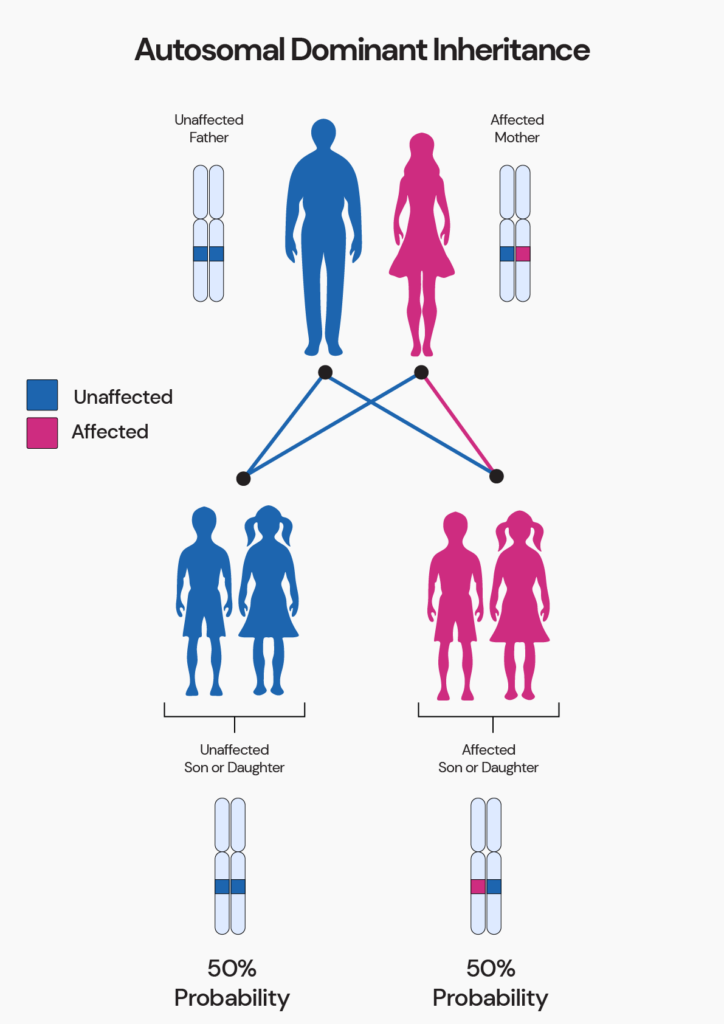
Different members of the same family have often been diagnosed with fibromyalgia.
You are 8.5 times more likely to get the syndrome if you have a first-degree relative, such as a parent, sibling, or offspring, with the syndrome.
Researchers discovered that 28% of the children whose mothers had fibromyalgia also had the condition.
There are many risk factors for fibromyalgia. However, merely possessing one of the risk factors listed below does not guarantee that you will get the syndrome.
Gender
Women are more likely than men to have fibromyalgia because estrogen and other female reproductive hormones make women more sensitive to pain.
During women's menstrual cycle, estrogen levels rise and fall, and pain levels oscillate.
Another possible risk factor for fibromyalgia is menopause, which causes decreasing estrogen levels.
Age
According to the NFA, between the ages of 20 and 50, most patients with fibromyalgia have been diagnosed.
Sleep abnormalities
Fibromyalgia is particularly prevalent in some persons with sleep disorders such as sleep apnea and restless leg syndrome (RLS).
Autoimmune disorders
The likelihood of getting fibromyalgia is higher in people with other autoimmune disorders. These disorders include:
Mental health issues
Hormonal imbalances cause mental health disorders such as depression and anxiety, the underlying factor for developing fibromyalgia.
Depression may also result from the pressure of dealing with persistent pain. Additionally, depression can exacerbate your pain.
Other potential risk factors for fibromyalgia include environmental triggers, recurrent surgery, inactive lifestyle, excessive exercise, and obesity.
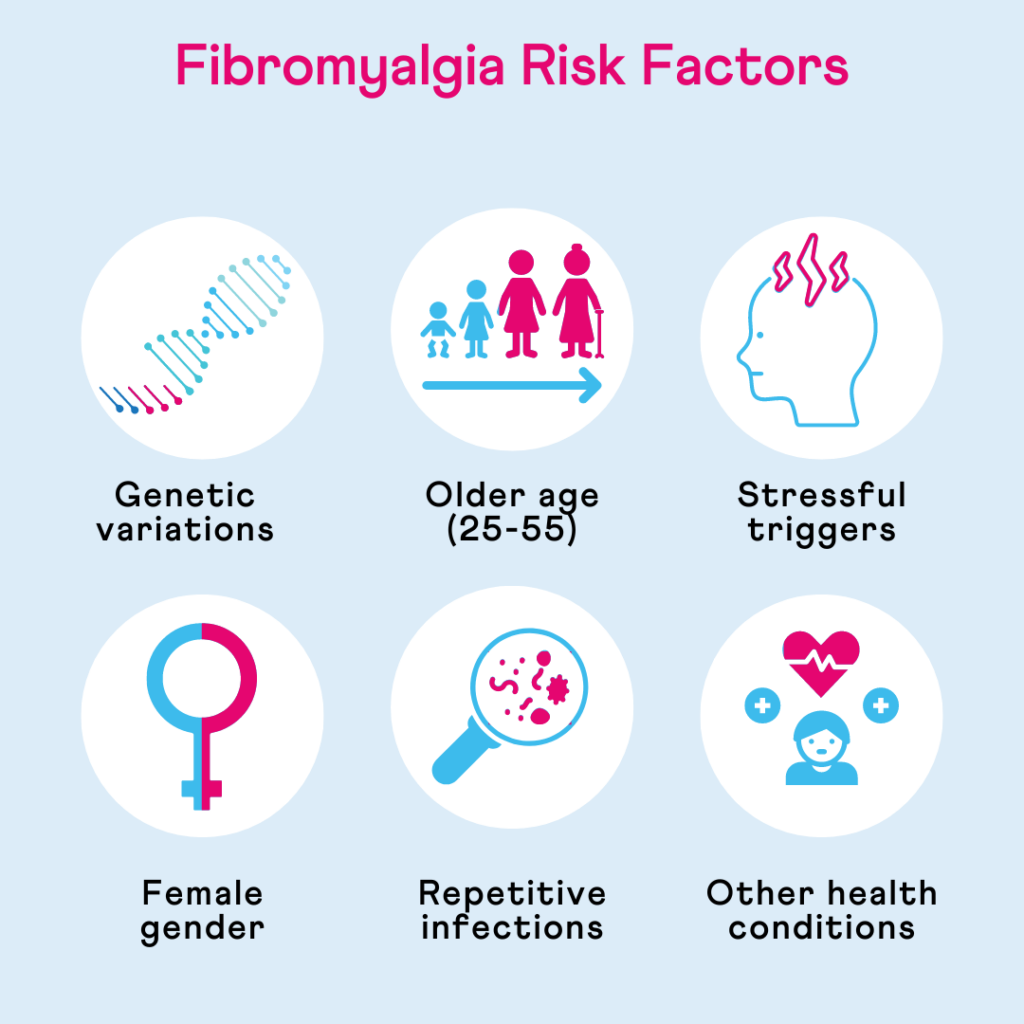
Fibromyalgia patients frequently share a few health concerns. Doctors have correlated the following risk factors to fibromyalgia.
You are highly susceptible to developing the condition if you have:
Being overweight makes fibromyalgia pain worse.
Fatigue and many other ailments are made worse by having too little muscle and too much body fat.
According to studies, exercising and lowering weight can reduce pain while improving daily function.
Based on a 2018 study, people with higher weights, body fat percentages, and fat mass experienced more widespread fibromyalgia pain.
Subsequent studies have connected being overweight and having high-fat mass to more severe fibromyalgia cases.
TLDR - I raised a request with 23andMe for expedited access to my DNA raw data. I was instructed to submit a government-approved proof of ID. Upon submitting my driver's license, I was able to access my data within 48 hours!
Update: 23andMe downloads are back! Login to your account to download your data for deeper health and wellness insights!
I got my 23andMe ancestry test done in August, and while I downloaded my reports, I never bothered downloading my raw data.
A few days back, I came across Xcode Life, a company that uses existing DNA raw data to provide comprehensive health and wellness reports.
I saw that for the holidays, they have slashed their popular Genome Pack’s price by 47% and immediately placed an order for it.
I quickly logged in to my 23andMe account to download my data, only to be faced with this.

Recently, a hacker advertised that they had stolen millions of “pieces of data,” breaking into the DNA relatives feature that allowed the users to compare ancestry information with users worldwide.
While 23andMe is looking into this and attempting to solve this issue, they have blocked the download of DNA data indefinitely as a security measure.
I wasn’t too particular about asking Xcode for a refund as I didn’t want to miss this holiday sale.
The customer support from Xcode assured me that my order would be safe with them and that I could upload my DNA data whenever I am able to access it.
Additionally, they also offered me a cashback on my order as a token of appreciation for my patience.
I then decided to approach 23andMe to ask them whether they could make an exception and share my DNA raw data with me. Here’s how I was able to do it.
Step 1: I first went to the “Help” section of my account and clicked on “Contact Us”


Step 2: I wasn’t able to get in touch via call, and the chat option kept giving me automated responses. So I chose to email them.

Step 3: Here’s what I wrote on the submission form:
I would like to download my DNA raw data file as I have placed an order with a 3rd party DNA analysis company.

I got an acknowledgment email immediately after.
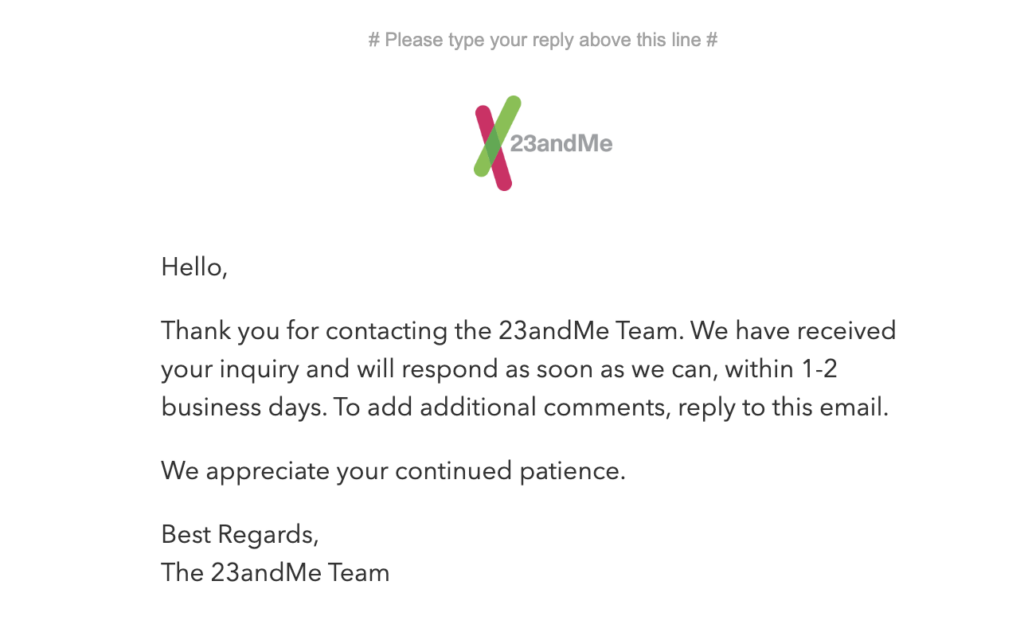
Within the next couple of days, to my delight, I got another email that gave instructions on downloading my data.
All I have to do is reply to that email with a valid ID proof, and I’ll be able to access my data!

Step 4: I have replied to that email with my driver’s license attached. They say that I should have my DNA data within 4 weeks. But I feel I’ll be able to access it much earlier!
Update
Within 48 hours of submitting my ID proof, I got access to my DNA raw data file!

Aging gracefully is not just about having wrinkle-free glowing skin. Maintaining adequate muscle mass and preventing age-related loss can play a significant role in how one experiences the aging process. Adequate muscle mass, power, and strength are essential for better mobility and balance and also help protect against age-related conditions, such as osteoporosis. In this article, we'll delve deep into the importance of muscle mass for healthy aging and explore what vitamin stops age-related muscle loss.
Did You Know? Your genes play a crucial role in influencing your vitamin levels. Even if you have a healthy diet, if there are any variations in your DNA that impact the absorption or metabolism of vitamins, you may be at risk for nutritional deficiencies. Learn more.
A decline in muscle mass is a normal part of aging, but that does not mean you cannot stop it.
Age-related muscle mass is called sarcopenia.
Did you know your muscle mass decreases approximately 3% to 8% per decade after age 30?
Most men will lose about 30% of their muscle mass during their lifetimes.
A reduction in muscle means decreased flexibility and less mobility, which increases the risk of falls and fractures.
A 2015 study states that people with sarcopenia had a 2.3 times higher risk of having a low-trauma fracture from a fall.
Muscle strength is the fitness component that refers to the ability of a group of muscles to exert force.
The reduction in muscle strength has been attributed to reduced activity of the muscle group.
When we learn about muscle power, we do so in the context of skeletal muscles.
Skeletal muscles are the voluntary muscles found in different parts of the body like arms, legs, hands, feet, hips, jaw, etc.
These muscles move when you want them to move, unlike those found in the abdomen (called involuntary muscles).
Just like other cells and tissues in the body, skeletal muscles also undergo aging changes, which results in loss of muscle mass, strength, and power.
Age-related muscle loss is very subjective and depends upon several factors, like gender, age, lifestyle factors, genetics, and activity level.
Besides muscle-related aging changes, there may be muscle weakness due to nerve-related issues.
This may also cause a loss of muscle power.
Some reports suggest that muscle weakness in old age may be due to the reduced ability of the individual to control their skeletal muscles.
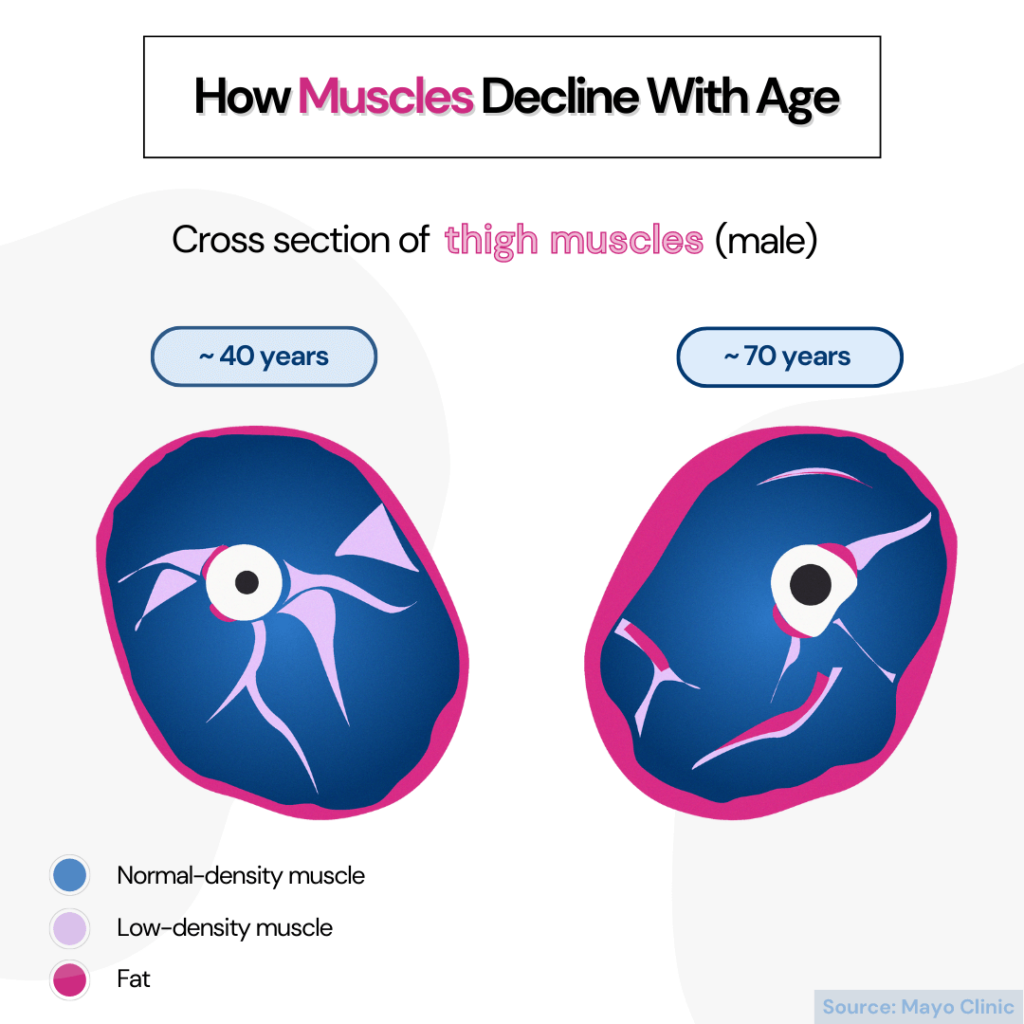
Here are some reasons why muscle mass and power are essential:
Loss of age-related muscle mass and power has been correlated with disability.
For example, the extensor muscle in the knee is predictive of how you perform your daily activities, like rising from a chair, climbing stairs, etc.
A lack of muscle mass reduces power in the knee extensor muscles, making it difficult to perform these regular activities.
Older adults are prone to falls.
Falls usually occur when you lose balance after slipping or tripping.
With aging comes a loss in muscle mass, strength, power, and coordination, all of which increase the risk of slips and trips, leading to falls.
Nutrition and diet are essential in ensuring optimal muscle mass while aging.
While bone loss has always been blamed for the increased risk of fractures and other injuries among older adults, sarcopenia has recently received more attention.
Loss of the fast-twitch fibers (muscle fibers that support quick and powerful movements), proteins, and the development of insulin resistance may have a role to play in the loss of muscle strength and the development of sarcopenia.
A few nutrients that are required to maintain optimal muscle mass, especially during aging, are:
Besides ensuring an adequate intake of these nutrients, it is essential to ensure optimum acid-base balance.
Two important vitamins that can reduce age-related muscle loss are vitamins C and D.
A 2020 research from the University of East Anglia (UEA) shows that older individuals who ate a lot of vitamin C had the best skeletal muscle mass.
Vitamin C consumption is associated with skeletal muscle mass.
According to a study, circulating vitamin C levels are positively associated with skeletal muscle mass in middle-aged and older men and women.
This vitamin has strong antioxidant properties and defends cells and tissue from free radical damage.
These free radicals contribute to muscle destruction and loss and accelerate age-related muscle decline.
The study does not recommend consuming heavy doses of the vitamin.
Eating a citrus fruit like an orange or sweet lime daily and a vegetable rich in vitamin C is sufficient for most people.
Vitamin D regulates the structure and function of several body systems, including the skeletal muscles.
This vitamin stimulates the proliferation and differentiation of skeletal muscle fibers, thereby maintaining and improving muscle strength.
While vitamin D deficiency is widely prevalent across various age groups, it is particularly pronounced in the geriatric population.
This may be due to low dietary intake and reduced exposure to UV rays of the sun.
A deficiency of vitamin D in older individuals may contribute to sarcopenia.
Several studies have shown that low serum vitamin D levels are linked to loss of muscle mass and a decline in muscle strength.
This is more pronounced in men than women.
Research also states adequate nutritional intake or vitamin D supplementation can effectively prevent and treat sarcopenia in older adults.
However, more studies are needed to determine vitamin D's exact role in preventing and treating sarcopenia.
Can Vitamin D And B12 Deficiency Occur Together?
Muscles are groups of fibers, where each fiber is made up of blocks of proteins called myofibrils.
Each myofibril comprises a protein called myoglobin.
For this reason, adequate protein intake is essential to maintain optimum muscle mass.
While most Americans consume more than the required amount of protein, inadequate protein in the diets of older adults is common.
Compounding the problem is the decreased capacity of older adults to digest and absorb protein.
Several studies suggest that the protein requirements of older adults are higher than those of younger individuals.
Older adults must consume high-quality protein to support and preserve their muscle mass and maintain muscle strength and power.
Two types of exercises can help you gain muscle mass after 50:
These exercises consist of performing exercises that activate metabolism using short cycles of stretching and shortening the muscle fibers.
An excellent example of this type of exercise is basketball practice.
During these exercises, repetitive movements are performed at a constant speed.
The weight can be modified while maintaining the same speed.
For those over 50, here are some ways to gain muscle mass and improve muscle strength, power, and endurance:
Endurance exercises engage and work the slow-twitch muscle fibers through various repetitions.
These fibers can stay contracted for a long time.
Regular and continuous training helps make these slow-twitch fibers stronger and more efficient.
Examples of endurance-building exercises include brisk walking, running, jogging, cycling, and climbing stairs.
You must start small and slow when you are building muscle post-50.
Weight training is a type of resistance exercise.
It is one of the best ways to reverse age-related muscle loss and benefits people of all genders and ages.
Weight training is recommended to be done 2 to 3 times a week and helps increase muscle mass and improves flexibility.
It also lowers the risk of cardiovascular diseases, obesity, and strain on the various joints, improves back strength, and relieves pressure on the spine.
Resistance bands are another excellent way of improving your overall muscle mass.
Using these resistance bands correctly creates tears in the muscle fibers.
Your body repairs these muscles by adding more muscle. This usually occurs 72 hours after exercising.
Other exercises like squatting, hip lunges, pushups, etc., work larger groups of muscles, engage your joints and improve muscle strength and power.
Always consult with your healthcare provider to know more about the best exercises for you.
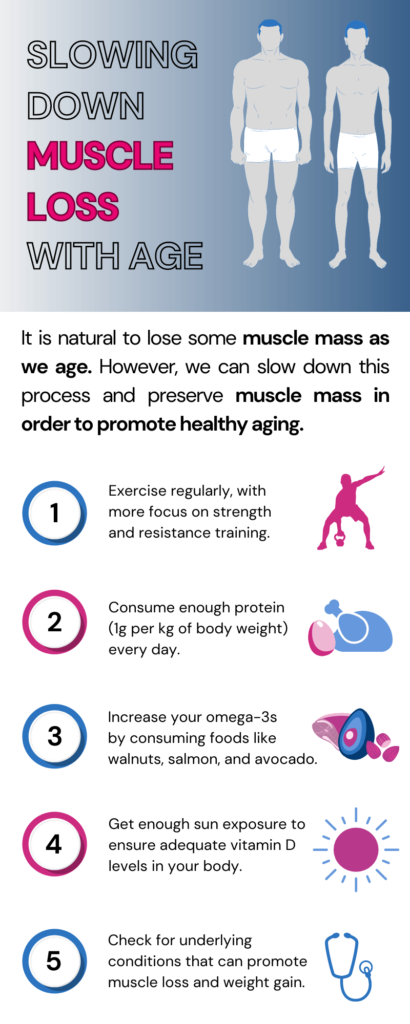
DNA, the blueprint of life, encodes the genetic details that define us—from our family roots to potential health concerns and even the traits that set us apart. However, delving into this intricate code to draw meaningful insights isn't always straightforward. Enter DNA Painter: a user-friendly tool designed to help us navigate and interpret our DNA information more clearly. In this article, we'll explore the capabilities of DNA Painter, diving into its features, and help you determine if it’s the tool you've been searching for to decode your genetic heritage.
Xcode Life is a DNA analysis platform that helps you get the most out of your ancestry test DNA data. From your health risks and allergies to sleep behavior and food patterns, the DNA reports allow you to take proactive measures for your health, thereby boosting your healthspan and lifespan. You can upload your DNA data to learn 1,500+ things about your health. Learn more.
DNA Painter is a website launched in 2018 by Jonny Perl, a web developer and genealogist from London. He created the website as a hobby project to help him and other genealogists make sense of their DNA results.
Since then, DNA Painter has become one of the most popular and innovative tools in genetic genealogy. It won the grand prize in the DNA Innovation contest at RootsTech in 2018.
DNA Painter helps you visualize and analyze your DNA matches using chromosome mapping. It allows you to paint your chromosomes with different colors according to the segments you share with your relatives.
Doing so lets you identify your common ancestors, estimate how closely you are related, and learn more about your genetic heritage.
DNA Painter offers various services and tools for DNA analysis, such as:
Chromosome mapping: This is the most popular tool on DNA Painter. It allows you to visualize the segments of DNA you share with your matches and to map those segments to your ancestors. This can help you to determine how you are related to your matches and to identify unknown ancestors.
Ancestral trees: This tool on DNA Painter is a way to visualize your family tree. You can create a tree manually or import a GEDCOM file. It offers features to add DNA matches, color-code your tree, and export it to a GEDCOM file.
What Are the Odds? (WATO): This tool estimates the probability of how you are related to your DNA matches using a statistical model and the known inheritance patterns of DNA.
Cluster Auto Painter: This tool allows you to group your DNA matches into clusters based on shared matches. You can also color-code the clusters, label them, and export them.
Shared cM Project Tool: This tool helps you to calculate the amount of DNA you share with your matches in centimorgans (cM). This information can be used to estimate how closely you are related to your matches.
These are just a few of the many tools available on DNA Painter. If you want to learn more and see the right tools according to your needs, you can explore their official website.
Hand-picked Content For You
How To Use 23andMe Family Tree?
To use DNA Painter, you must have tested your DNA with one of the major testing companies, such as AncestryDNA, 23andMe, MyHeritage, FamilyTreeDNA, or Living DNA.
Then, upload your DNA data file to a third-party website that provides segment data, such as GEDmatch or MyHeritage.
Here’s how you can do it on GEDmatch:
Go to the website and upload your DNA data.

Copy the data as shown in the image below.

Next, create a free account on DNA Painter and start painting your chromosomes.
Follow these steps:
Step 1: Visit the profile page and click "Create a new profile."

Step 2: Mention your name and gender and click "Save and start painting."

Step 3: Click "Paint a new match.”

Step 4: A popup will now appear.
Step 5: Paste the segment data you generated earlier on GEDmatch. Click “Save match now."

Step 6: Enter match details, including your relationship and ancestor's name. Select the relation side (paternal/maternal). Choose desired colors and add notes. Click "Save match."



Step 7: Congrats! You have successfully painted your first match now. Repeat the process for as many matches as you want (subscription required).

Images source: DNA Painter
You don't need to order anything to use DNA Painter. This website is accessible online and free for anyone to use.
However, if you want to access some extra features, you can subscribe to DNA Painter for a 12-month fee of $55.
Additionally, you can enjoy a one-time discount of $5.00 by enrolling in their monthly mailing list.
Here are the steps to assist you in subscribing to their services.
Step 1: Go to dnapainter.com and log in to your account.

Step 2: Click "Subscribe" at the top-left navigation bar of the homepage.

Step 3: Go through the package and click the "Subscribe Now" button.
Step 4: Enter your desired payment details and confirm your order.

Images source: DNA Painter
Since DNA Painter is an online tool, there is no turnaround time. You can use it immediately after creating an account and uploading your data.
However, the time for analyzing and visualizing genetic data using DNA Painter cannot be generalized.
It depends on the complexity of your data and how deeply you want to explore your genetic connections.
DNA Painter has gathered the attention of various experts and enthusiasts. Its impact has resonated with the following notable individuals regarding DNA Painter's effectiveness.
Blaine Bettinger, a genetic genealogy expert, says:
“DNA Painter is an easy-to-use tool that helps genealogists make sense of DNA testing. By mapping segments of DNA to chromosomes, we can begin to see which ancestors gave us which pieces of DNA and, thus, how new matches are related. As a result, DNA Painter has quickly become an essential tool for genealogists!”
Nathan Dylan Goodwin, author of genealogical crime mysteries, tweeted:
"I love all the DNA Painter tools. I need more time to make use of them!"
Another Twitter user, a genetic genealogist, admires the tool's visual appeal. They admit to regularly using the "What Are the Odds?" (WATO) tool and chromosome mapper, implying a positive overall experience with DNA Painter's features.
A random user on Reddit attests to the tool's excellence, praising its ability to visualize connections, test hypotheses, and manipulate data effectively. They highlight DNA Painter's impeccable design and comprehensive functionality, making it an exceptional resource for genealogical research.
While the basic version of DNA Painter is free, it provides fundamental tools for chromosome mapping and segment analysis within its limits.
However, a subscription can become valuable as it offers additional features that significantly boost your genealogical research efforts.
Let's understand the differences in features through the table below:
| Feature | Free Membership | Subscription |
| Tools (e.g., Shared cM/ WATO) | Access to all tools | Access to all tools |
| Chromosome mapping | Limited to 1 | Up to 50 |
| Bulk import functionality | No access | Unlimited access |
| Trees | Limited to 1 | Upto 50 |
| Gedcom import | Up to 4th generation | All generations |
Note: We recommend checking the official source for the most current and accurate pricing details.
Pros:
Cons:
Use Your Ancestry Test DNA Data For 1000+ Health And Wellness Insights
DNA Painter's privacy policy is fairly ironclad due to its clear statements about data collection, use, protection, and limitations.
Users are provided transparent information about how their data is handled and safeguarded.
Despite the robust policy, users must remain cautious and consider potential risks, especially when interacting with third-party websites or services.
DNA Painter is a website that helps you visualize and analyze your complex DNA results, simplifying the puzzle of genetic information.
It offers various services and tools for DNA analysis, such as chromosome mapping, ancestral trees, WATO, and Cluster Auto Painter.
To use DNA Painter, you must have tested your DNA with one of the major testing companies, such as AncestryDNA, 23andMe, MyHeritage, FamilyTreeDNA, or Living DNA.
You can then upload your DNA data file to a third-party website that provides segment data, such as GEDmatch or MyHeritage.
Once you have your segment data, you can create a free account on DNA Painter and start painting your chromosomes.
Experts and enthusiasts have praised DNA Painter's effectiveness in helping people understand their DNA results.
DNA Painter is free, but the subscription is worthwhile if you wish to access additional features.
Have you ever wondered why some people have blue eyes while others have brown? Or why some folks are more likely to get certain diseases? It's all about our genes, the instructions passed down from our parents, making us who we are. But not all genes are the same. Some have tiny differences, called genetic variants, in their code. These variants can change how a gene works and affect our appearance and health. Read on to explore genotyping, a way to find these genetic variants in an individual or a population. We will cover the definition and process of genotyping, its potential applications, and future implications for health and research.
Genetic ancestry tests are becoming increasingly popular. While your DNA can be used to learn about your roots, did you know that it can also reveal important things about your health risks and wellness aspects? This allows you to take proactive measures for health conditions, even before the symptoms appear, thereby preventing it. You can upload your DNA data to learn 1,500+ things about your health. Learn more.
Genetic variants are differences in the DNA code of genes or chromosomes. They are what make every organism unique.
For example, they can cause differences in facial features, hair color and texture, body shape, and other physical traits.
Even identical twins have some key differences in traits due to highly subtle variations in their DNA.
Genetic variants can occur naturally during DNA copying or repairs or due to radiation or chemicals. Some come from our parents, while others occur in our lifetime.
People with the same trait have the same allele or version, of a gene.
For example, people with blue eyes share the same allele for eye color, while those with brown or hazel eyes have different alleles.
Single nucleotide polymorphisms, or SNPs, are common variations in our DNA.
Think of DNA as a long chain of tiny building blocks called nucleotides. Sometimes, one of these building blocks differs in a person's DNA.
For example, it might replace the nucleotide thymine (T) or cytosine (C). These differences, or SNPs, happen naturally in our DNA.
On average, there's about one SNP in every 1,000 building blocks. This means there are around 4 to 5 million SNPs in a person's DNA.
This variation should be present in at least 1 percent of the population to be called a SNP. Scientists have found over 600 million of these SNPs in people worldwide.
Most of these SNPs are usually found in the spaces between our genes. They act like signposts, helping scientists find genes related to diseases.
Sometimes, SNPs are found within or close to a gene, which can affect how that gene works, possibly playing a role in diseases.
Most SNPs don't impact our health or development at all. But some of them are crucial in understanding our health.
SNPs can tell us how a person might respond to certain medications, how susceptible they are to toxins, and their risk of getting certain diseases.
They can also help track how these genetic differences are passed down in families.
Scientists continually study SNPs to find links between them and complex diseases like heart disease, diabetes, and cancer.
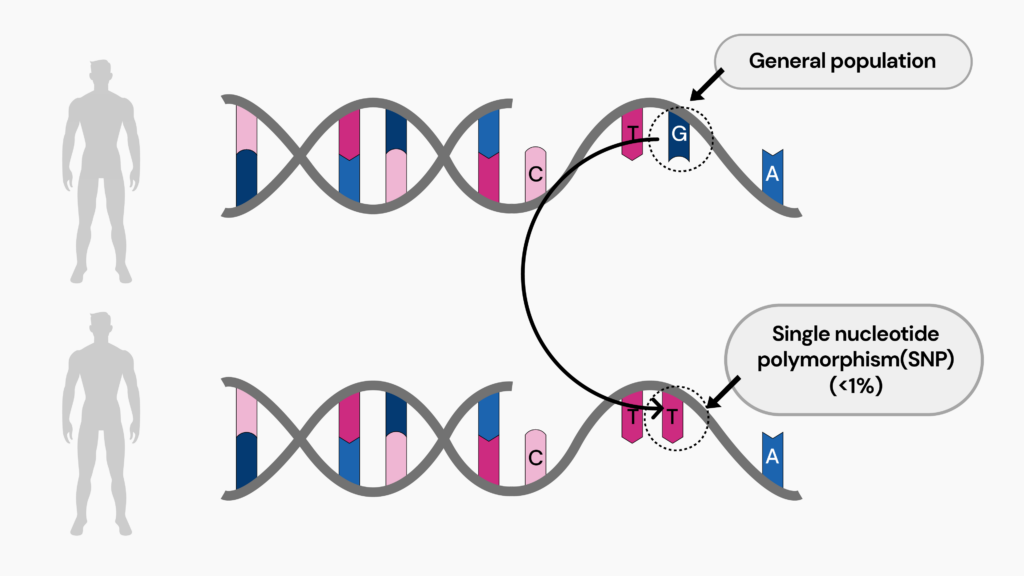
Genotyping is the scientific procedure of identifying variations or dissimilarities in an individual's genetic makeup, also known as the genotype.
It involves analyzing an individual's DNA sequence and comparing it to another individual's DNA sequence or a reference DNA sequence.
Genotyping can reveal an individual's ancestry, traits, health risks, drug responses, etc.
Genotyping is used in a wide range of applications, including:
SNP genotyping focuses explicitly on identifying and analyzing individual genetic variations (SNPs) in DNA to study their links to traits, diseases, and other genetic factors.
Also Read: How Accurate Are Home DNA Tests
Genotyping can be performed using a variety of technologies. Here are some commonly used ones:
The technology depends on the sample type, the number of gene variations that need checking, and the available budget.
Genotyping can help assess one's risk of developing certain diseases by recognizing genetic variations linked to them.
For example:
Nonetheless, relying alone on genotyping is insufficient for determining disease risk since numerous additional factors play a role, including:
Hence, it is advisable to combine genotyping with additional sources of information.
These sources include family background, medical history, clinical examinations, and biomarkers, which can provide a more precise and comprehensive risk assessment.
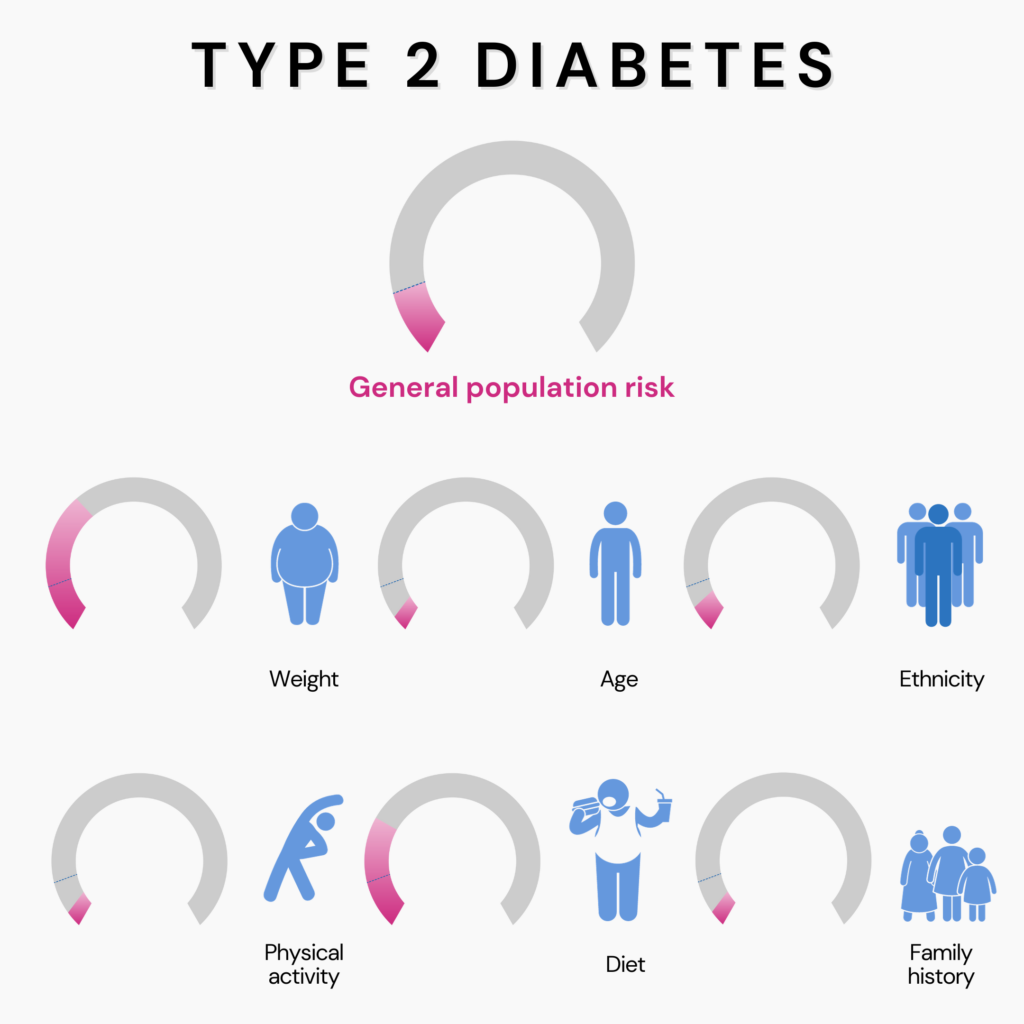
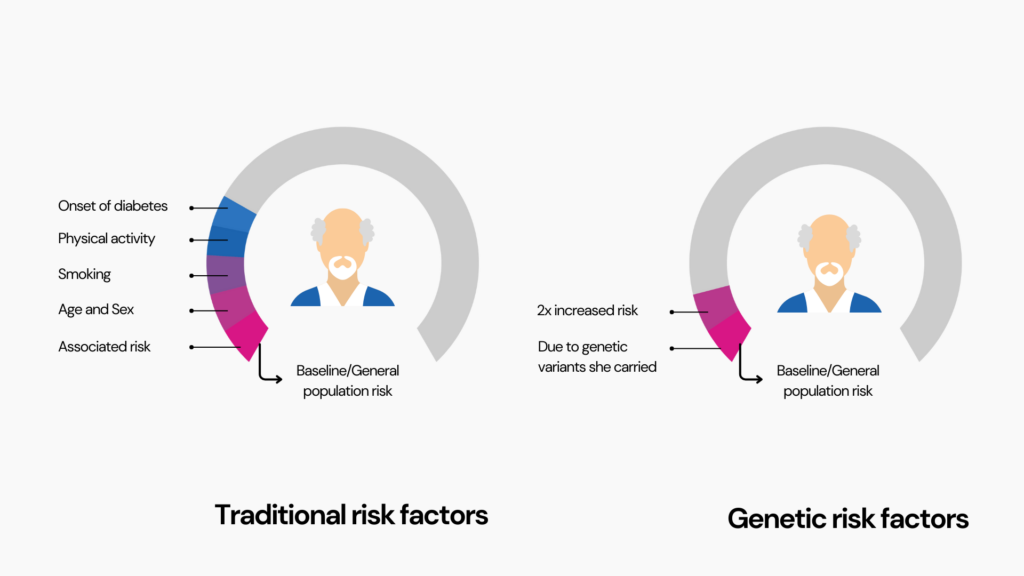
Variations detected from genotyping can be associated with specific traits in several ways.
One common method is a genome-wide association study (GWAS), where they compare the genes of many people with a trait to those without it. This reveals genetic differences linked to the trait.
Another way is through linkage studies, where they check if a genetic marker and trait are often passed down together in families. If they do, it suggests a nearby gene affects the trait.
Once these genetic links are found, researchers determine how they impact traits. They might see how genes are used or test them in animals.
Remember, the connection between genes and traits is complicated. Multiple genes and environmental factors influence traits. Additionally, some genetic variations may have different effects in different people.
Download Your 23andMe Data For 1000+ Health And Wellness Insights
The future of genotyping holds remarkable implications and advancements that will significantly impact various aspects of our lives:
While the future of genotyping is promising, it's essential to recognize that ethical and social concerns accompany these advancements.
Privacy, data security, and discrimination issues must be addressed through ethical guidelines and regulations.
These measures are essential to ensure the responsible and fair use of genotyping technologies for the benefit of all, including equitable access to genotyping services.
Did You Know?
Your DNA Influences If You Will Ever Participate in Genetic Studies
Genotyping has some limitations and risks that one should consider before getting tested.
Here are some pros and cons of genotyping that help you make an informed choice.
Pros:
Cons:
Genotyping is about understanding genetic variations in DNA.
Genetic variants are what make each person unique, influencing traits and health.
One type of variation, Single Nucleotide Polymorphisms, is common and can affect health.
Genotyping is the process of finding these variations by analyzing DNA. It has various uses, like medical diagnoses, solving crimes, and improving crops.
But, it's essential to combine it with other information for accurate health assessments.
The future of genotyping looks promising with more precise methods, affordability, and new applications.
It will enhance disease diagnosis, personalized medicine, and agriculture.
However, ethical concerns, like privacy and discrimination, must be addressed.
When considering genotyping, carefully assess the pros (ancestry and health insights) and cons (surprising data, limited health view, privacy, and ethics).
https://medlineplus.gov/genetics/understanding/genomicresearch/snp/
https://pubmed.ncbi.nlm.nih.gov/37026777/
https://www.ncbi.nlm.nih.gov/pmc/articles/PMC3512287/
https://link.springer.com/protocol/10.1385/1-59259-840-4:399
https://www.genome.gov/genetics-glossary/Genome-Wide-Association-Studies
https://www.ncbi.nlm.nih.gov/pmc/articles/PMC3267991/
https://www.nia.nih.gov/health/alzheimers-disease-genetics-fact-sheet
https://www.cancer.gov/about-cancer/causes-prevention/genetics/brca-fact-sheet
https://www.nhlbi.nih.gov/health/cystic-fibrosis/causes
Have you ever caught yourself and your brother reaching for the same snack, noticed that your sister's laugh echoes yours, or why you both can’t stand cilantro? It's no coincidence; these traits may well be written into your DNA. Siblings share a significant amount of their genetic material, which often accounts for those shared quirks and preferences. But just "how much DNA do siblings share?" is the question we're unpacking in this article. Read on to learn more about the significance behind sharing DNA.
Genetic ancestry tests are becoming increasingly popular. While your DNA can be used to learn about your roots, did you know that it can also reveal important things about your health risks and wellness aspects? This allows you to take proactive measures for health conditions, even before the symptoms appear, thereby preventing it. You can upload your DNA data to learn 1,500+ things about your health. Learn more.
Genetic code is a set of rules that cells use to translate genetic information from DNA or RNA into proteins.
It is a sequence of nucleotides present in the DNA or RNA.
The nucleotide consists of a sugar molecule, a phosphate group, and a nitrogen-containing base.
In DNA, the bases are adenine(A), guanine(G), cytosine(C), and thymine(T).
Each genetic code uses these four nucleotides to spell three-letter codons in various ways.
These codons specify which amino acid is needed at each position within a protein.
Siblings can be either full siblings or half siblings.
Full siblings share the same biological parents.
Maternal half-siblings share the same mother, while paternal half-siblings share the same father.
Two individuals share the same DNA they inherited from their recent ancestors.
Testing how much DNA two individuals share can reveal if they are related.
You will share longer stretches of DNA with your relative than a non-relative.
If you share at least one continuous region of matching SNPs (Single Nucleotide Polymorphisms) longer than the threshold of 7 centimorgan, you could be relatives.
Distant relatives are less likely to be detected using this method, as they share shorter stretches of DNA segments.
How much DNA siblings share depends on their relationship with each other.
It also depends on whether they have one or both parents in common.
It can be anywhere from 25% to 50%.
Siblings DNA tests can determine whether two people are full or half siblings.
Siblings inherit 50% of their DNA from each parent.
Half of the siblings share 25% DNA.
50% of each half-sibling's DNA comes from the shared parent.
They inherit half of the same DNA from that shared parent.

DNA is organized into chromosomes.
Humans have 46 chromosomes, of which 23 are from their mother's side and the rest from their father's.
So, parents and children share 50% of their DNA.

Full siblings often don't share 100 percent of the same DNA.
It often needs to be clarified for people who use popular genetic testing kits like those made by AncetryDNA or 23andMe.
It is due to a process called genetic recombination.
It is a phenomenon where the body cuts the number of chromosomes in half when creating eggs or sperm.
Of the 46 human chromosomes, sperms and eggs carry only 23.
Due to this genetic trimming, cell chromosomes exchange genetic material before forming an egg or a sperm cell.
Each egg and sperm cell has its unique combination of genes.
Thus, both siblings do not inherit the same 50% from each parent, making them similar but not identical.
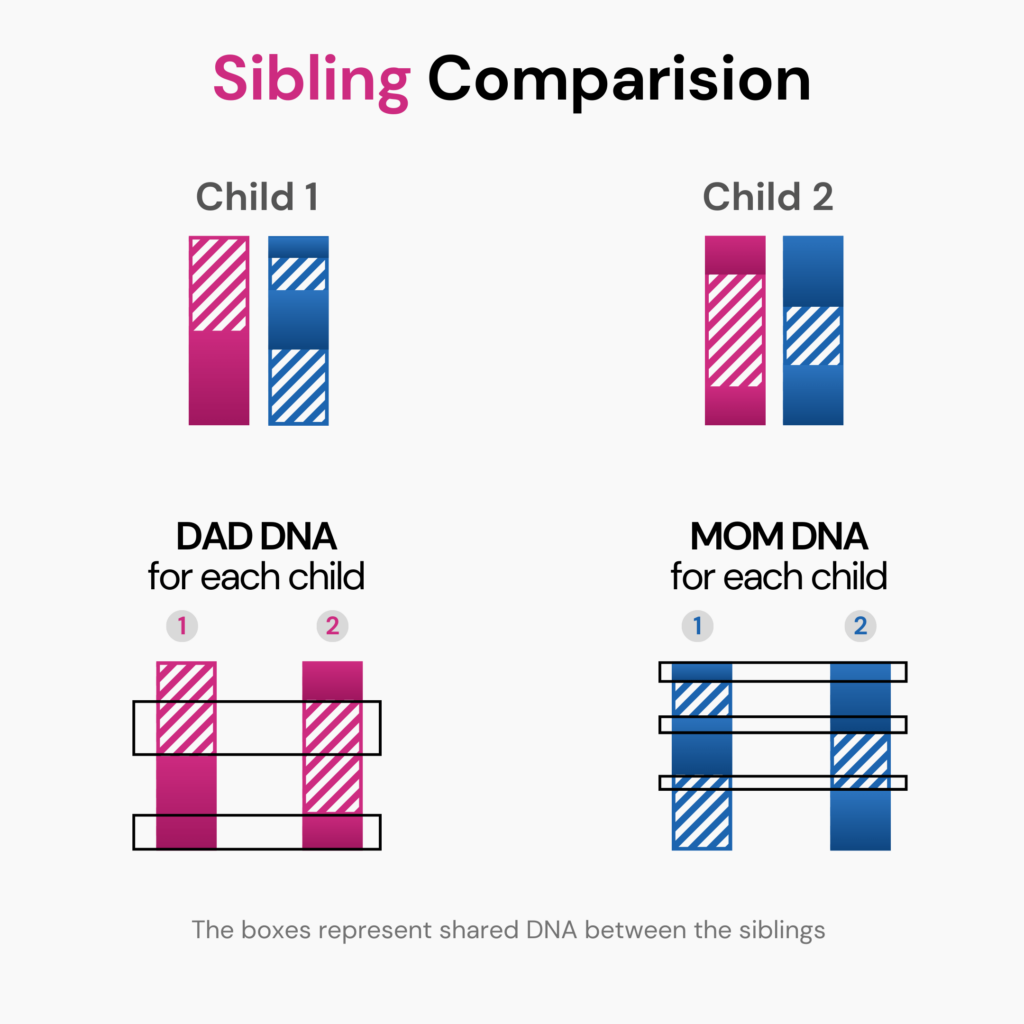
Identical twins are also called monozygotic twins.
They develop when one fertilized egg splits into two, whereas fraternal twins develop when two eggs are fertilized by two different sperms simultaneously.
Theoretically, identical twins share 100% of the same DNA, while fraternal twins, just like siblings, share 50%.
However, genetic mutations can still occur, and a small number of identical twins may not share the entire 100% DNA.
You are almost undoubtedly full siblings even if you share only 38% DNA with your sibling.
Here, 38% is equivalent to 50%.
There are two different ways to count the DNA shared by two people, which leads to this variation.
There are two ways to tally the regions of DNA called "fully identical" by the DNA testing companies.
The second method is more popular.
Hence, in this case, 38% is equivalent to 50%.
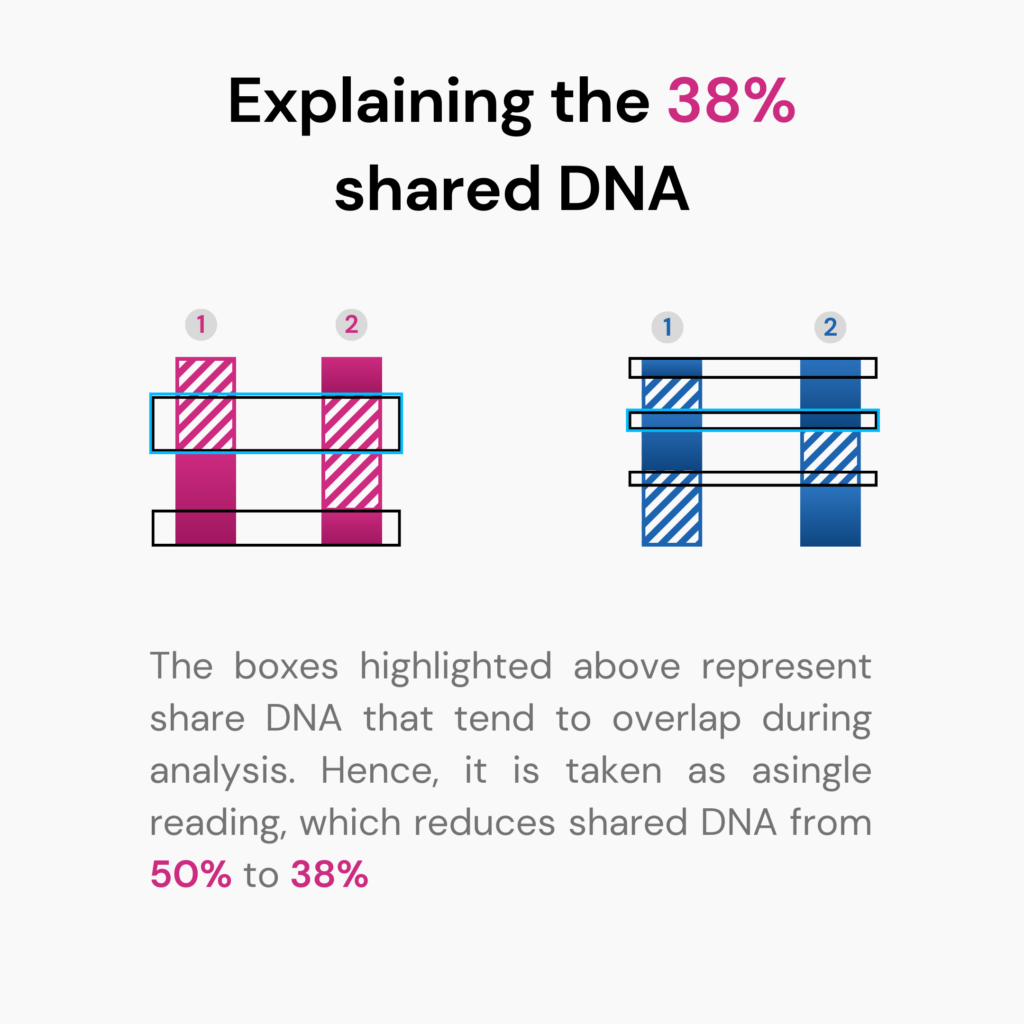
Determining how much DNA siblings share is essential for several practical reasons.
It can help solve paternity disputes and child custody cases.
It can also be helpful for organ transplants, where determining a sibling becomes essential when choosing a donor.
When siblings take a DNA test, the result is usually similar.
Surprisingly, two siblings from the same family and with the same parents can have vastly different ethnicity results.
Many factors can affect genealogical ethnicity.
DNA mutates over time and makes copies of itself.
Single-nucleotide polymorphisms (SNPs) are tiny portions of DNA that remain unidentical when copied.
These SNPs can determine family lineage and genealogy.
For example, if you have an SNP that only appears in Egyptians, the odds are that you might be an Egyptian relative.
An exciting consequence is that you and your siblings can show different relative matches.
Because the DNA does not exactly match with your sibling, the relatives you are matched with may be different as well.
Legal sibling DNA testing results may be used to solve child custody disputes.
It can also be used to establish the parenthood of an individual in court cases such as child support and social security.
Such a DNA test must be conducted under a proper "chain of custody."
It simply means that the sample must be collected in front of the judge or a representative appointed by the court.
A sibling DNA test determines the amount of shared DNA between two people.
It can determine whether two people have one or both familiar parents or neither mother nor father in common.
Unlike a paternity test, sibling testing does not provide a genetic profile that matches at every step.
In this test, a siblingship index is calculated.
A siblingship index value of less than 1.00 indicates that two people are unrelated.
While a value above 1.00 indicates that two people might be whole or half-siblings.
The sample needed for a sibling DNA test can be collected using an oral swab.
The test results usually arrive within 7-10 working days.
Download Your 23andMe Data For 1000+ Health And Wellness Insights
Understanding how much DNA siblings share has always been exciting and valuable.
Siblings share similar but not identical DNA due to a phenomenon called recombination.
DNA shares between half and full siblings can also differ widely.
Understanding how much DNA siblings share can help solve paternity and child custody cases.
It can help understand family lineage better.
It can also help in determining a possible donor for an organ transplant.
https://atlasbiomed.com/blog/do-siblings-have-the-same-dna-the-facts-on-family-genetics/
https://pubmed.ncbi.nlm.nih.gov/1955016/